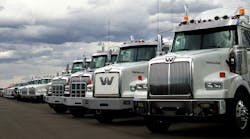The Teamsters, trucking trade magazines, bloggers (including myself) and now the Huffington Post. All are weighing in on the issue of Mexican trucks operating within the U.S. border.
A couple areas of the report caught my attention, including one aspect that I believe tells the “real” story, if you read between the lines, as to why there are so many opponents of the program.
“According to FMCSA, California still has not adopted the rule, but continues to use an equivalent rule. Instead of putting a violator out of service, California can either fine the violator $1,000 or order the violator to return the vehicle to the country of origin. In addition to assessing a fine against violators, California may also impound the vehicle and its cargo until the fine and impoundment charges are paid. FMCSA stated that it considers California’s requirement that the vehicle be impounded to be compatible with its rule.”
Based on this interpretation by FMCSA, it only adds fuel to the fire for opponents, particularly the Teamsters, who claim that unsafe Mexican trucks would be on U.S. roads, putting lives at jeopardy. Of course it would. If trucks that should otherwise be put out of service for violations are allowed to continue to operate on U.S. roads; that puts lives at risk. It also calls into question the program. How can anyone objectively determine whether allowing Mexican trucks beyond the commercial border zones is appropriate if we can’t even get our own rules consistent? Imagine how Mexican carriers feel? Which rules do they follow? And in what states do they have to follow them? No wonder there is so much confusion.
The report also details out-of-service rates for U.S.-based and Mexican-based carriers inspected by U.S. inspectors. And do you know what it finds? There is no major difference in the rates. There is, though, a major difference in the average number of inspections per carrier. U.S. domiciled carriers faced an average of eight inspections each in all years from 2006 to 2008 with out-of-service rates of 22.3% in 2006, 21.7% in 2007 and 21.8% in 2008. Mexican-based companies faced 46 inspections per carrier in 2006 with a 20.9% out-of-service rate. In 2007, the numbers were 48 and 21.6% and 51 and 21.2% in 2008.
Also of note was the percentage of drivers placed out of service due to license violations. U.S. based drivers were put out at the rate of 7.3%, 7.2% and 6.9% from 2006 to 2008, respectively. Their Mexican counterparts? How about 1.2%, 1% and 1.2%. That’s mighty interesting. Again, though, it’s difficult to draw conclusions on the license violators because some states report the data in a timely manner, some do months later and some don’t bother to report the violators at all. It’s up to individual states to determine their own reporting practices.
“During our audit, we reviewed 11 truck inspection crossings and 5 bus inspection crossings and found that FMCSA continues to have the capacity to conduct meaningful truck and driver inspections at the southern border,” the report said. Since the report notes that FMCSA has enough auditors in place to conduct hours of service checks and “meaningful inspections” at 25 commercial border crossings, we can only conclude that “unsafe” Mexican trucks would not be driving on U.S. highways. Taking that a step further, if the arguments of the Teamsters and others are based on safety, as they say, then these numbers would dispel that myth. Instead, maybe opponents of the program should say what their real agenda is – that they’re afraid Mexican drivers, who work for less pay than their U.S. counterparts, would take jobs south of the border. That’s what this whole argument is really about.
You can read the full report here.





